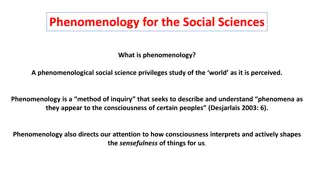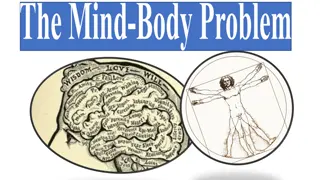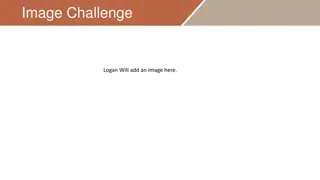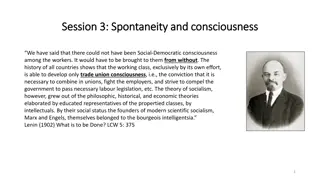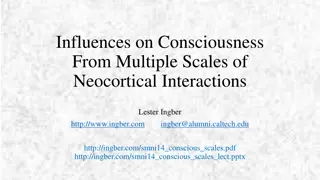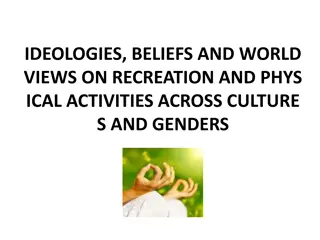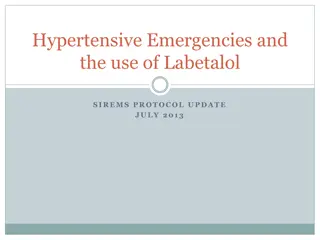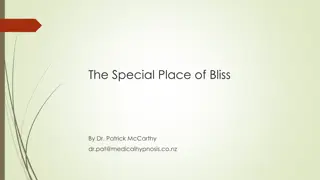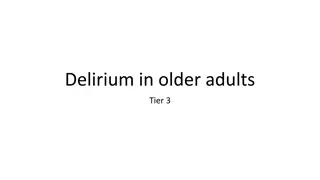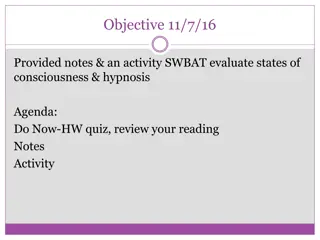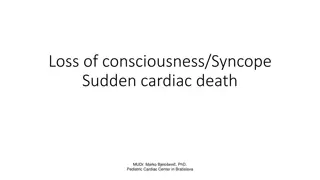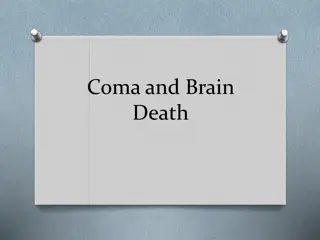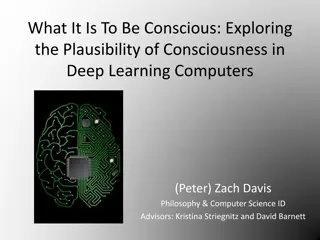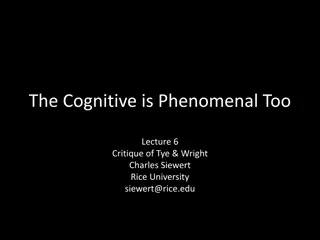Understanding Altered States of Consciousness: Trance Practices in Different Cultures
Explore the ethnographic work on trance practices in Middle America and the Caribbean, comparing and contrasting how possession and trance phenomena are organized into types by anthropologists. Discover how shamans induce trances through mechanisms like singing, chanting, drumming, and dancing, leading to intense visual experiences. Learn how these experiences induce relaxation and slow wave brain activity, providing insight into altered states of consciousness.
Download Presentation

Please find below an Image/Link to download the presentation.
The content on the website is provided AS IS for your information and personal use only. It may not be sold, licensed, or shared on other websites without obtaining consent from the author. Download presentation by click this link. If you encounter any issues during the download, it is possible that the publisher has removed the file from their server.
E N D
Presentation Transcript
ALTERED STATES OF CONSCIOUSNESS Trance Styles Exercise Adapted from eHRAF Teaching Exercises 1.26 Altered States of Consciousnessby Jack Dunnington, Carol R. Ember, and Erik Ringen.
TRANCE STYLES In this exercise, you will read, compare, and contrast ethnographic work on Middle America and Caribbean trance practices. Tibetan Rope Incense. By GrammarFascist CC BY-SA 4.0via Wikimedia Commons This Teaching Exercise is provided by the Human Relations Area Files at Yale University in New Haven, CT
E X E R C I S E D E T A I L S EXERCISE DETAILS TIME: 35 minutes MATERIALS REQUIRED: HRAF Access Worksheet and pen or other materials for recording answers STUDENT LEARNING OUTCOMES: At the end of this Exercise, studentswill be able to: describe and explain differences in possession and trance phenomena demonstrate knowledge of how these differences have been organized into types by anthropologists use the possession typology to categorize trance and possession phenomena in the ethnographic records of multiple societies. construct effective and efficient search strategies in eHRAF in order to retrieve data relevant to a specific topic/assignment. This Teaching Exercise is provided by the Human Relations Area Files at Yale University in New Haven, CT
This Teaching Exercise is provided by the Human Relations Area Files at Yale University in NewH Trance and other altered states of consciousness are strongly associated with healing practices of shamans, a subset of magico- religious healers. Hupa Female Shaman. Photo by Edward S.Curtis. Public Domain Image, via Wikimedia Commons. This Teaching Exercise is provided by the Human Relations Area Files at Yale University in New Haven, CT
Among shamans, trances are usually induced by mechanisms such as singing, chanting, drumming, or dancing, after which the shaman in training or practice collapses and becomes unconscious and has intense visual experiences. TRANCE AND SHAMANISM Shamanof the Yenisei-Ostiaks(Sumarokova, Sept. 16th) . 1914. Nansen Fridtjof Wedel-Jarlsberg. Public DomainImage. This Teaching Exercise is provided by the Human Relations Area Files at Yale University in New Haven, CT
TRANCE STATES These experiences presumably induce a state of relaxation that replaces fast brain activity in the front areas of the brain with slow wave activity representing more emotional information (Winkelman 1986) Portraitof a medicineman,Navajo,intrance. EdwardS Curtis. Wellcome Images CC BY 4.0. via Wikimedia Commons This Teaching Exercise is provided by the Human Relations Area Files at Yale University in New Haven, CT
Institutionalized trances are generally divided into experiences in which the soul is believed to leave the body, we will call those TypeA TYPE A The Pythia, or high priestess who held court at Pytho, would channel prophecies from Apollo in a dreamlike trance seated above medicinal smokes. Oracle ofDelphi Entranced. Detail of Etching by HeinrichLeutemann. Public DomainImage. CT This Teaching Exercise is provided by the Human Relations Area Files at Yale University in NewHaven,
The Sanghyang dance is a sacred dance performed by two young girls. Duringthis dance,it is believed that a force enters the bodyof an entranced performer and takes over her movements. Photo of Sang Hyang Dans by Tropenmuseum, part of the NationalMuseum of World Cultures CC BY-SA 3.0via Wikimedia Commons and experiences in which a person s body is possessed or taken over by a spirit, we will call those TypeB TYPE B This Teaching Exercise is provided by the Human Relations Area Files at Yale University in New Haven, CT
METHODS OF INDUCTION Different methods are used to induce trances cross- culturally. These methods can require excessive physical movement (including shamanic drumming and dancing mentioned above), but may also involve sleep deprivation, fasting, sleep, and psychoactive drugs. A shaman in Huancambamba, Peru imbibes tobaccoand other medicines inthe midst of a ritual for healing a sick patient. Image: Curandero Singando Por La Fosa Nasal Izquierda en Huancabamba, Piura, Peru. Sebasti n Casta eda VitaCC-by-4.0 This Teaching Exercise is provided by the Human Relations Area Files at Yale University in New Haven, CT
CORRELATIONS IN TRANCE INDUCTION METHODS These types of behaviors are not haphazard; if sleep deprivation is present, fasting and social isolation are often also present, such as when a young person goes alone into the forest on a quest for a guardian spirit. Moreover, these types of induction methods rarely are associated with possession trance (Winkelman 1986) Dramaticized image of Indian shamanhealing a sick patient,distributed as a novelty item ona postcard. Henry Solomon Wellcome. held by NARA Pacific Alaska Region. Public Domain Image via WikimediaCommons. This Teaching Exercise is provided by the Human Relations Area Files at Yale University in New Haven, CT This Teaching Exercise is provided by the Human Relations Area Files at Yale University in New Haven, CT
SLEEP TRANCE If sleeping is the induction method, trance usually involves a non-possession trance such as a soul journey. Possession trances, on the other hand, are associated with subsequent amnesia, convulsions, and spontaneous onset of trances (Winkelman 1986). A Tao priest enters deep meditative trance during which his spirit embarks upon a journey. Illustration from Richard Wilhelm The Secret of the Golden Flower . PublicDomain Image via WikimediaCommons This Teaching Exercise is provided by the Human Relations Area Files at Yale University in New Haven, CT
ASSIGNMENT PART 1 Using ADVANCED Search in eHRAF, search for the subject altered states of consciousness (trances) using its corresponding OCM code (Ecstatic Religious Practices, 786 OR Revelation and Divination, 787) in conjunction with the word trance*. Narrow your search to include only cultures within the Middle America and Caribbean subregion. Browse through the search results of these 5 cultures: Garifuna (Gonzalez document), Haitians (Laguerre document), Huichol (Myerhoff document), Kuna (Chapin document), and Miskito (Conzemius document). Look for examples of each type (A or B) of institutionalized trance and note them. This Teaching Exercise is provided by the Human Relations Area Files at Yale University in New Haven, CT
ASSIGNMENT PART 2 Question 3: How many examples of each type (A & B) did you find? (5 minutes) Question 2: What criteria did you use to identify them? (5 minutes) Image of Eastern Passage, Knowth, Ireland, where cavernous hallways and rooms are thought to have been used by ancient people s to induce altered states of consciousness. Photo By Przemys aw Sakrajda CCBY- SA 3.0 via WikimediaCommons This Teaching Exercise is provided by the Human Relations Area Files at Yale University in New Haven, CT
ASSIGNMENT PART 3 Question 3: How does the definition of types in anthropology, such as types of ritual behavior as we discussed here, become useful for ethnographic or anthropological research? (5 minutes) Question 4: Are there limits to the value of types and models for grouping and explaining human variation? If so, please describe. (5 minutes)? Question 5: How should anthropologists balance the benefits of typologies with the limits of typological models? (5 minutes) This Teaching Exercise is provided by the Human Relations Area Files at Yale University in New Haven, CT
This Teaching Exercise is provided by the Human Relations Area Files at Yale University in New Haven, RESOURCES Assignment Rubric, Tips,References Balinese Legong Dancers 1953.P. (Paul) Spies . TropenMuseum, part of the NationalMuseumof World Cultures.CC bySA3.0 via Wikimedia Commons
RUBRIC The following rubric is suggested for evaluating responses: Unsatisfactory (0%) NeedsImprovement (25%) Satisfacto ry (75% Outstandi ng (100%) Unsatisfactory Assignment Part 1: Questions1-2 Needs Improvement Satisfactory Outstanding Answers are absent or mostly incomplete Answers are paritally complete and accurate Answers are complete and accurate Answers are only partially completed and/or inaccurate Needs Improvement Outstanding Satisfactory Commentary on research findings is not comprehensive and /or persuasive. Major points are addressed, but not well supported. Responses are inadequate or do not address topic or response to the questions Specific examples do not support topic or response to the questions. Evaluation and analysis of research findings is accurate. Major points are stated. Responses are adequate and address the question at hand. Content is accurate A specific example from the research is used. Evaluation and analysis of research findings is accurate and persuasive. Major points are stated clearly and are well supported. Responses are excellent and address questions Content is clear. Several specific examples from the research are used. Unsatisfactory Assignment Part 3: Questions3-5 Major points are not clear. Specific examples are not used. This Teaching Exercise is provided by the Human Relations Area Files at Yale University in New Haven, CT
FURTHER READING For more information on altered states of consciousness across time, space, and society check out the Altered States of Consciousness module by Carol Ember and Christina Carolous in HRAF s Explaining Human Culture database. For a more detailed version of this particular exercise with additional questions and activities check out eHRAF Teaching Exercises 1.26 Altered States of Consciousness by Jack Dunnington, Carol R. Ember, and Erik Ringen. Check out the Advanced Search Tutorial for detailed instructions on conducting searches in eHRAF World Cultures. For more exercises and teaching resources related to human societies past and present, explore Teaching eHRAF This Teaching Exercise is provided by the Human Relations Area Files at Yale University in New Haven, CT
REFERENCES Winkelman, Michael. 1986. Trance States: A Theoretical Model and Cross- Cultural Analysis. Ethos 14 (2): 174 203. doi:10.1525/eth. 1986.14.2.02a00040 Winkelman, Michael. 2006. Cross-Cultural Assessments of Shamanism as a Biogenetic Foundation for Religion. In The Psychology of Religious Experience, edited by Patrick McNamara. Vol. 3. Where God and Science Meet. Westport, Ct.: Prager Publishers. This Teaching Exercise is provided by the Human Relations Area Files at Yale University in New Haven, CT






